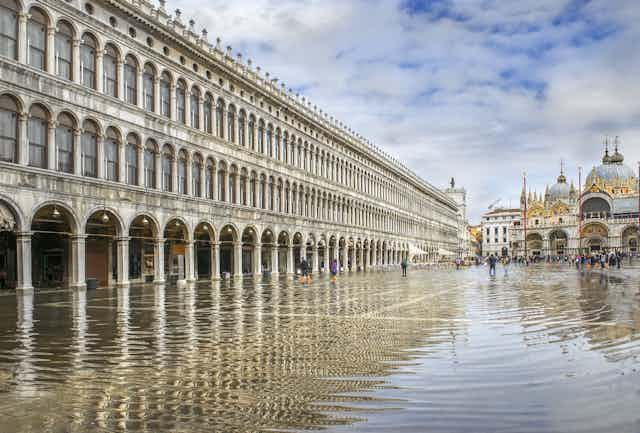Venice has flooded. But while worry about the worst floods in a decade and warnings about the impacts of climate change and sea level rise dominate most of the media coverage, there’s a more complex story to be told.
In Venice, floods are a feature, not a bug. The city was founded by people fleeing the Huns. They were safe in the lagoon (a word borrowed from Venetian), where horses and armoured men could not advance: the soggy ground would slow the enemy, the tide would wash them out.
Halfway between land and sea, trade is the only way to make a living. And so Venetians became successful merchants and built a magnificent city, with dazzling palaces and splendid churches filled with delightful works of art.
That city would flood every so often, when the tide was high and the wind pushed the waters of the Adriatic up north. But Venetian buildings are designed to withstand this, and city life bustles around the water.
The cost of protection
Venice has changed – it is primarily a tourist attraction now. Many locals have moved out, their houses converted to hotels, restaurants and holiday homes. The floods have changed, too. The rising sea pushes the flood waters ever higher, and this will get worse in the future. Stronger winds would exacerbate the problem.
The impact of climate change and sea level rise is moderated by adaptation. The Sumerians, the earliest known civilisation in Mesopotamia, knew how to build a dyke: 5,000 years have passed since, and we have learned a lot about how to protect our coasts.
Some places are easy to protect. The Piazza del Duomo in Pisa is vulnerable to erosion, but there is plenty of foreshore to build a dyke without spoiling the view of the Leaning Tower. London will need a new barrier eventually, and the only thing standing in its way is the government’s ability to decide and deliver large infrastructure projects.

Other places are much harder to protect. You can build a seawall in Miami but the water would seep right under it. A seawall would be effective in Dubrovnik but would spoil the Old City. A glass wall would be more appropriate, and expensive. Costs are a concern too in Leptis Magna – an ancient Roman city in Libya – as are kidnappings of skilled engineers.
Off the tourist trail
Research shows that cultural heritage is particularly vulnerable to sea level rise. Of 49 cultural world heritage sites located in low-lying coastal areas of the Mediterranean, 37 are at risk from a 100-year flood and 42 from coastal erosion. Up to the year 2100, flood risk may increase by 50% and erosion risk by 13% across the region, with considerably higher increases at individual world heritage sites.
Although Venice faces a serious threat from flooding, tourism generates so much money that the city can afford to protect itself. As a matter of fact, after the record floods of 1966, authorities decided to protect Venice. It took a while to agree on the design and the financing. Construction began in 2003 on a set of movable barriers that lie flat on the sea floor for most of the time, but close the inlets of the lagoon during high tides.
This set-up maintains the ecology and hydrology of the lagoon roughly as it is today, which is important as it is the largest tidal marsh in the Mediterranean. The first tests of the barriers have already been conducted. Full scale testing should commence in January 2019, and the project is due to be completed in 2022.
Reports of the death of Venice are premature: €6 billion was spent to make sure it will not drown below the rising sea. Why? Because it‘s worth it. The media focus on the impacts of sea level rise on places such as Venice feeds the needs of sensationalists. Many people have been there, or would like to go. 30m people visited Venice last year. The alarm is raised by the threat of seeing an iconic city destroyed by climate change. Except that in this case, the threat is baseless.
That is not to say that sea level rise is no concern. Cities such as Abidjan in Côte d'Ivoire, Accra in Ghana, Chittagong in Bangladesh, Jakarta in Indonesia, Lagos in Nigeria and Mumbai in India will face greater challenges, when it comes to shielding themselves from the rising sea. Poor and disorganised, the authorities have a hard time providing basic public services – they can ill afford a multi-billion dollar project to protect the coast.
The most worrying impacts of climate change will fall on those unable to adapt, and places off the beaten track face far greater obstacles than those on the tourist trail. Al Gore described climate change as a moral problem. Perhaps we should focus less on the cities and sights we know, which are ultimately safer from climate change, and more on the real destruction that climate change will cause.

